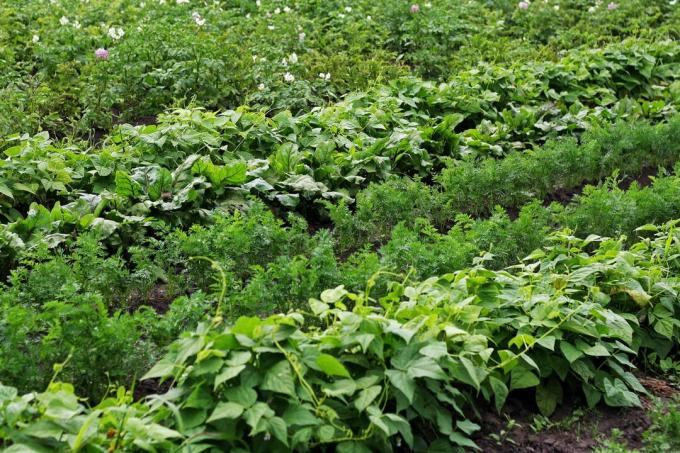Potatoes can be combined with various plants in the bed. We give tips on mixed cultivation, good neighbors and crop rotation after potatoes.

The potato (Solanum tuberosum) is being grown in more and more gardens for self-sufficiency. One mixed culture with other types of vegetables and herbs imitates a natural, species-rich form of cultivation and has significant advantages for gardeners and nature compared to a monoculture in the bed. In this way, the yield can often be increased and harmful organisms prevented. Below you will find tips for creating a mixed crop with potatoes and good neighbors. We also explain the benefits of crop rotation and which crops can be grown after potatoes.
contents
- Mixed cultivation of potatoes: Is a mixed cultivation worthwhile?
- Good neighbors for potatoes
- Crop rotation in potatoes: what to plant after potatoes?
Mixed cultivation of potatoes: Is a mixed cultivation worthwhile?
Mixed cultivation of potatoes has a number of advantages. The combination of the nutrient-hungry potatoes with more undemanding species protects the soil and prevents soil fatigue. Some cultures even hold Potato Pests down, shade the ground and thus reduce evaporation. The soil structure and microorganisms also benefit from a natural, diverse planting. In the long term, the fertility of the soil is maintained and sometimes even increased.

Good neighbors for potatoes
At a glance: Which plants go well with potatoes?
- beans (Phaseolus vulgaris)
- cauliflower (Brassica oleracea var. botrytis)
- broccoli (Brassica oleracea var. italiana)
- broad beans (Vicia faba)
- strawberries (Fragaria)
- Nasturtium (Tropaeolum majus)
- garlic (Allium sativum)
- Kohlrabi (Brassica oleracea var. gongylodes)
- Corn (Zea mays): sugar, grill or popcorn corn
- mint (mentha)
- spinach (Spinacia oleracea)
- savoy (Brassica oleracea convar. capitata var. sabauda)
- onion (Allium cepa)
In general, high-consumption potatoes should be paired with vegetables that have lower nutritional requirements to avoid depleting the soil. In a mixed culture, as many different plant families as possible should be planted side by side. Close relatives carry the risk of spreading diseases quickly and compete for the same nutrients. You should therefore not plant any nightshade plants (Solanaceae), and therefore neither aubergines (Solanum melongena) nor peppers (Capsicum annum) or tomatoes (Solanum lycopersicum) plant next to potatoes. Also zucchini (Cucurbita pepo subsp. pepo convar. giromontiina) do not go well with potatoes because they have a similarly high nutrient requirement. Potatoes should also not be planted with root vegetables as they will compete for underground space.

Shallow-rooted vegetables such as spinach or strawberries are the best choice here. So you can plant potatoes and beans together, as the latter also form a shallow root system. A special combination is the planting of a bed in Mixed culture of potato, pumpkin (Cucurbita), beans and corn. All of these cultures come from South America and have been planted in this combination of deep-rooted, upright, vine-climbing plants for thousands of years. The beans climb up the corn plants, while the squash covers the space between the plants and the potatoes mainly thrive underground. cabbages (Brassica) also get along well with tuber-forming plants. Planting potatoes and garlic together can voles (Arvicolinae) hold Peppermint and nasturtium are said to deter on snails (Gastropoda) and various insects, such as the Colorado potato beetle (Leptinotarsa decemlineata), works.

Crop rotation in potatoes: what to plant after potatoes?
Potatoes are good preceding crops themselves, meaning they prepare the ground for other species. The potato is important as a previous crop, especially on heavy soils, as its large root system loosens the soil. Potatoes are followed by medium-consuming root vegetables, such as carrot (Daucus carota), parsnip (Pastinaca sativa), salsify (Scorzonera hispanica) as Beetroot (Beta vulgaris) and swedes (Brassica napus subsp. rapifera). The following year, weakly consuming leafy vegetables such as salads, radish (Raphanus sativus), peas (Pisum sativum) or planted spinach. The following year, i.e. the third after the potato, is used to build up humus. One green manure serves to replenish organic matter for soil organisms, at the same time provides food for insects and covers the soil. This prevents dehydration and erosion. oil radish (Raphanus sativus), mustard (Sinapis alba), bee friend (Phacelia tanacetifolia) and cress (Lepidium sativum) are just a few of the many possible green manure plants.
Once a suitable area has been found in the garden for growing potatoes, the question arises next year at the latest: Can potatoes always be planted in the same place? Potatoes are basically self-compatible, so theoretically they can be grown after themselves. However, some potato diseases are soil-borne, which means that they survive in the soil for many years and can reinfect the plants from there again and again. Potatoes and their close relatives should therefore only be planted in the same area every 4-5 years.
Do you want to be successful too? grow potatoes? We give 10 useful tips from choosing a location to planting, care and harvesting to storing the nutritious tubers.

